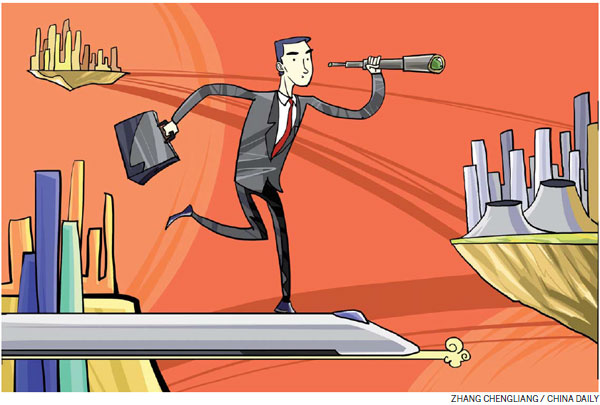Investors are not rushing for the door
Updated: 2015-10-02 09:44
By Han Bing(China Daily Europe)
|
|||||||||||
Many opportunities are opening up, and the inward flow of foreign capital has actually increased
The closing of factories in China by a few transnational companies, exaggerated as a "tide of foreign capital departure" by some, has attracted worldwide attention and sparked another round of unease over China's investment climate.
But what's the real picture? Has the investment climate deteriorated and which way is it headed?

A country's investment climate, closely linked to corporate profitability, directly affects its ability to attract foreign investment.
According to the World Investment Report 2015 of the United Nations Conference on Trade and Development, the inflow of FDI to China has risen 4 percent, against a worldwide decline in FDI inflow of 16 percent. FDI of $129 billion means China has surpassed the United States for the first time and become the leader. According to China's Ministry of Commerce, China's use of foreign capital grew steadily in the first half of this year, with 11,914 foreign-invested enterprises newly established, a year-on-year rise of 8.6 percent. Some 421 billion yuan ($66 billion; 59 billion euros) was actually utilized, a year-on-year rise of 8.3 percent.
The Business Environment in China 2015, issued by the American Chamber of Commerce in China, shows that over 60 percent of its member enterprises rank China in the top three destinations for international investment.
The European Union Chamber of Commerce in China says in a business confidence report that 61 percent of European enterprises consider China an increasingly important part of its global strategy. The annual report of the Japanese Chamber of Commerce and Industry in China says its domestic sales-based enterprises and industries are predicted to continue exploiting the Chinese market.
Data clearly show the steady trend of China absorbing foreign capital, giving lie to the "tide of foreign capital departure".

However, the past three decades of reform and development have fundamentally changed the investment climate, including continual increases in labor and land costs, the cancellation of super-national treatment enjoyed by foreign enterprises, increased restrictions on energy resources and activities that affect the environment, enhanced market competitiveness of state-owned enterprises and the growth of private enterprises. Also, the government has shifted from a policy of "take all comers" to one of "admit the best applicant", indicating a preference for quality over quantity.
In 2007, China began to optimize foreign capital utilization, encouraging foreign investment in new energy and environmental protection technology, while restricting investment in projects involving high consumption of materials and energy, heavy pollution and use of scarce minerals resources. It encouraged a shift to high value-added industries.
It is only normal that some enterprises that depend on intensive use of labor and resources would leave China. Noticeably, while China's traditional advantage of low-cost manufacturing has weakened, foreign investment in the Chinese service industry has grown rapidly.
In the first half of this year, utilized foreign capital in the service industry rose by 23.6 percent year on year to reach a record 63.5 percent of the total foreign investment in China, 33 percent higher than the manufacturing industry, according to the Ministry of Commerce.
The unveiling of the China (Shanghai) Pilot Free Trade Zone in September 2013 is a great example of how a new chapter has been opened in foreign investment management reform. The preestablishment national treatment and negative list model requires less administrative handling, relaxes restrictions on foreign investment, grants businesses the opportunity to participate in fair market competition and increases the transparency of the management system.
The three major laws governing foreign investment are being revised to develop a stable, transparent and predictable climate. The publication of the PRC Foreign Investment Law draft for comments in January is a part of the official plan to revise and combine the three basic laws on the utilization of foreign capital - the Enterprise Laws of Chinese-Foreign Joint Ventures, the Law on Foreign-funded Enterprises, and the Law of the People's Republic of China on Chinese-Foreign Contractual Joint Ventures.
The draft stipulates that the case-by-case examination and approval system for foreign investment will be gradually abolished and a "limited permission and comprehensive reporting" system that fits with the preestablishment national treatment and negative list model will be adopted to help stimulate market vitality and change government functions.
Controls on the admission of foreign investment have been relaxed. The new version of the Industrial Guidance Catalog for Foreign Investment approved by the State Council substantially reduces restrictions, with 41 restricted items, five encouraged items and two forbidden items deleted.
Specialized intellectual property rights courts have been established to strengthen IPR protection, which has been a bone of contention for foreign enterprises over the years. Protecting legitimate rights in accordance with the law in the new normal, innovation-driven economy is crucial. The Standing Committee of the National People's Congress decided to establish IPR courts in Beijing, Shanghai and Guangzhou and, last November, the first IPR court opened in Beijing, charting a new course of IPR protection in China.
The Chinese government also values collaboration with other countries in enhancing the global competitiveness of China's business by negotiating and signing international economic and trade agreements. These include the free trade agreement signed with South Korea on June 1 and the one signed with Australia on June 17, after 10 years of negotiation. Negotiations over Sino-US and Sino-European investment agreements have advanced. All these agreements will help foreign investors in China better deploy their global production and maximize profits.
These investors are embracing a new round of development opportunities like the free trade zone - reform's testing ground - which has adopted the negative list model and will further relax controls on the admission of foreign capital. That means that under similar conditions, foreign enterprises will be treated just like domestic enterprises.
The relaxation of controls on infrastructure and public utilities industries is another highlight of the first half of this year.
The State Council has promulgated the Method Regarding Franchising and Management of infrastructure and public utilities to attract social capital to the development and operation of these areas. It says legal entities inside and outside China can conduct franchise businesses through fair competition, in infrastructure fields including energy, transport, water conservancy, environmental protection, municipal administration and public utilities, as well as participating and profiting in investing, developing and operating infrastructure and public utilities industries within a limited scope and period.
This indicates that foreign enterprises could also invest in these areas as long as they meet the laws and regulations on the admission of foreign capital. Departments issued a series of opinions on the implementation of government incentives, such as preferential tax policies, in fields like railway development, hospital administration and toll roads.
The benefits that the reform and opening-up policies create are being unveiled. Challenges, risks and opportunities lie ahead. Foreign enterprises need to carefully consider how to adjust their strategies to seize development opportunities, while continuing to be law-abiding corporate citizens, the fundamental premise for success in the Chinese market.
The author is a researcher with the Institute of World Economics and Politics, Chinese Academy of Social Sciences. The views do not necessarily reflect those of China Daily.
(China Daily European Weekly 10/01/2015 page10)
Today's Top News
Russia starts airstrikes against terrorists in Syria
Li: China will meet main goals
Xi celebrates National Day with ethnic representatives
China marks Martyrs' Day at Tian'anmen Square
Ten industries prioritized for upgrading manufacturing ability
Hong Kong tycoon rejects claims about divestment from mainland
Beijing tops China's hourly minimum wage
Obama, Putin meet at UN on Syria, Ukraine
Hot Topics
Lunar probe , China growth forecasts, Emission rules get tougher, China seen through 'colored lens', International board,
Editor's Picks

|

|

|

|

|

|






